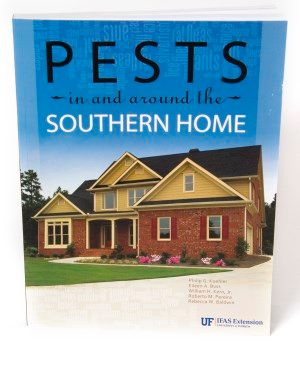
Credit: UF/IFAS
Introduction
Carpenter ants are in the genus Camponotus, in which up to over 900 species have been described worldwide. They get their common name, "carpenter ant," because some species excavate nests in wood. Carpenter ants are sometimes called bulldog ants or bull ants. However, not all species in the genus Camponotus are true carpenter ants because some nest in preformed cavities or in soil. Two carpenter ant species that are common around structures in the South are the Florida carpenter ant and the Tortugas carpenter ant. These bicolored arboreal ants are among the largest ants, making them apparent as they forage or fly indoors and out (Figure 1).
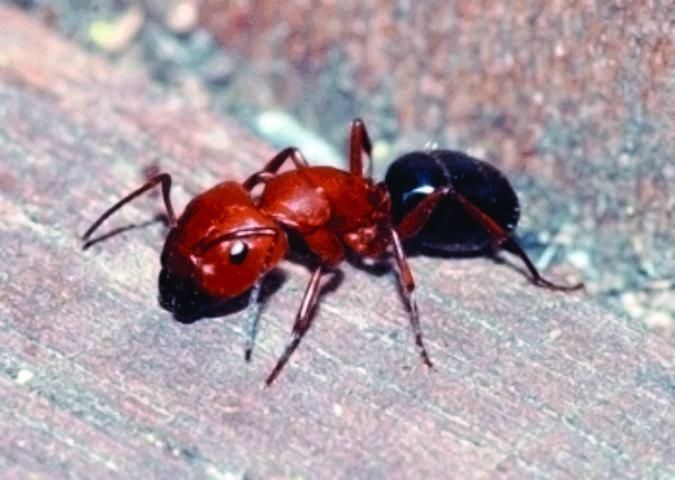
Credit: www.tamu.edu
During the flight season, carpenter ants can be found in alarming numbers. They have medium to large colonies and are very opportunistic in their nesting habits. Colonies of carpenter ants can be found in soil beneath objects, in dead branches of trees, and in rotting logs and stumps. They are active year-round and are serious house-infesting ants. Sometimes homeowners are concerned about damage to the structural integrity of their homes, which they sometimes have misidentified as caused by Florida carpenter ants. However, unlike the wood-damaging black carpenter ant, found in Florida's Panhandle, and a few other western US species, Florida carpenter ants seek either existing voids in which to nest or excavate only soft materials such as rotten or pithy wood and Styrofoam. The main nests for the black carpenter ant (Figure 2) are usually found outside, with satellite nests found indoors within voids or under insulation. Carpenter ants are primarily nocturnal in their foraging behavior. Carpenter ants do not sting but they do bite and can spray formic acid into the fresh wound if the ant is not removed quickly.

Credit: Steve Jacobs, PSU
The Florida carpenter ant is found widely distributed throughout Florida north to North Carolina and west to Mississippi and into Louisiana. The Tortugas carpenter ant is limited to central and southern portions of Florida and tends to be mainly a nocturnal forager. The black carpenter ant is found throughout the eastern and central United States and southeastern and south central Canada. In some areas of central and south Florida, large populations of the compact carpenter ants (Camponotus planatus) may occur.
Description
The Florida carpenter ants have antennae that are 12-segmented with no club. There is usually a circular ring of hair at the end of the abdomen forming the acidopore. The waist consists of one petiolar segment commonly referred to as a node. Workers vary in size, ranging from 5.5 to 10 mm in length. Smaller workers are called minors, while larger workers are called majors. Winged females (alates) are the largest caste, reaching up to 20 mm in length. Carpenter ants have no stinger, but workers can bite and spray formic acid for defense. The thorax is evenly convex; a key characteristic of carpenter ants. The thorax and head are ash brown to rusty-orange, and the gaster is black (Figure 3). Body hairs are abundant, long, and golden. Male reproductives are much smaller than queens with proportionally smaller heads and larger wings.
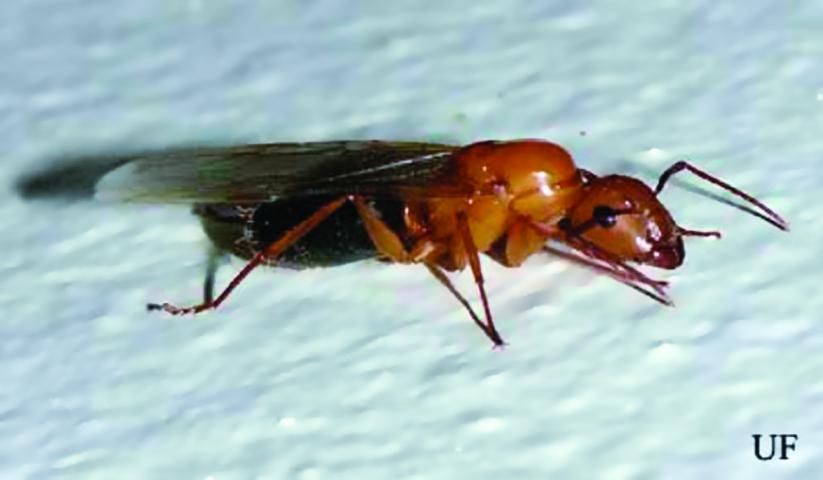
Specific characters for the Florida carpenter ant include legs and antennal scapes with numerous long, coarse brown to golden erect hairs, shorter than those on the body. For the Tortugas carpenter ant, specific characters include a major worker with head longer than broad; tibia of all legs and antennal scapes without erect hairs; and thinner than the Florida carpenter ant and paler with less color contrast (Figures 4 and 5). The Tortugas carpenter ant workers are 6 to 11 mm in length. The Tortugas carpenter ant workers tend to be reddish brown with their heads darker than the thorax, and their gaster is dark brown or black. Black carpenter ant workers are 6 to 13 mm in length. Their head, thorax, petiole (node), and gaster are dull black with pale yellow or light pubescence. The hairs found on the gaster are coarse, dense, and erect.
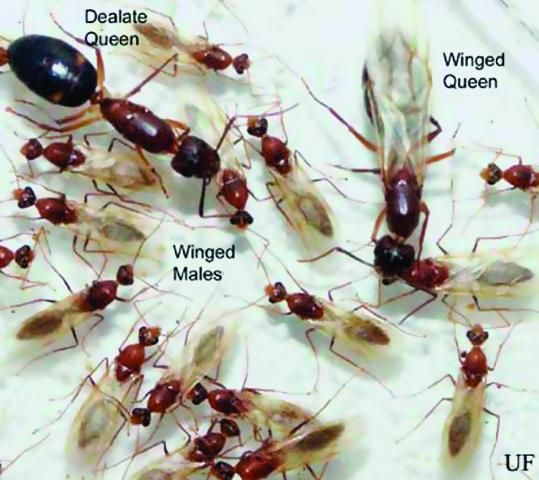
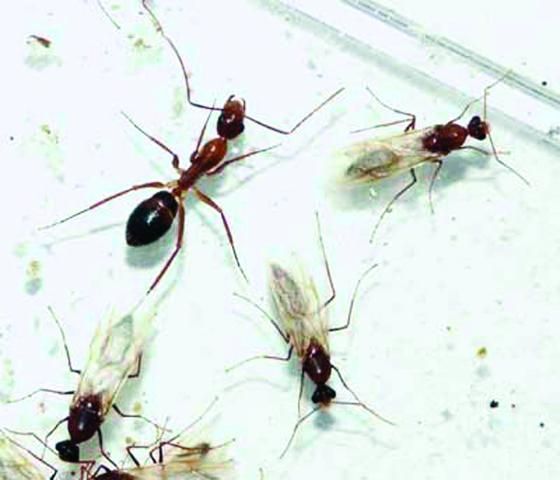
Life Cycle
Carpenter ants develop through complete metamorphosis, going through stages of the egg, larva, pupa, and adult worker or reproductive (alate). Carpenter ants create new colony sites when winged male and female reproductives emerge from a nest and depart for a mating flight. The mating flights of carpenter ants take place in the spring and are triggered by environmental factors such as photoperiod and changes in temperature. Winged reproductives fly in the evening or night during the rainy season (May through November). At the conclusion of a mating flight, the newly fertilized queen falls to the ground, breaks off her wings, and begins her search for a suitable nest site (Figure 6).
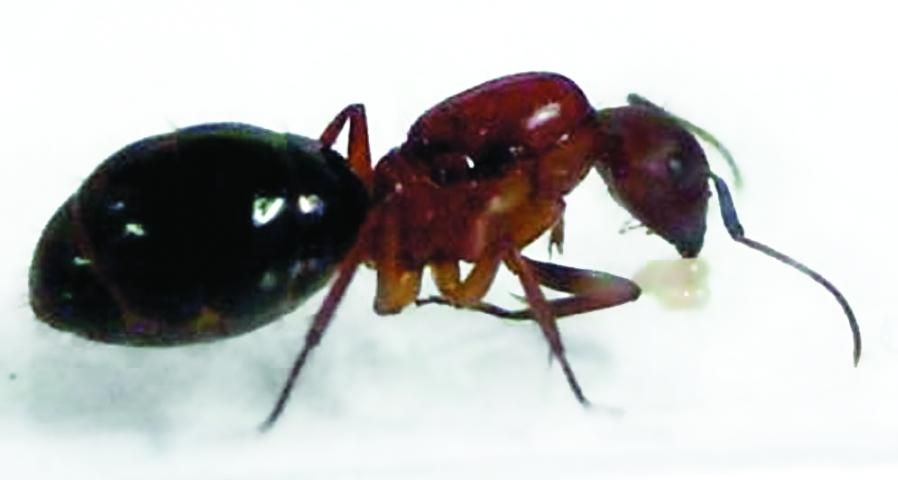
Carpenter ant nests are often started under loose bark or wood debris on the ground. The queen seals herself off in a chamber and rears her first brood in isolation. Larvae are maggotlike and progress through four instars. The mature larva spins a web of silk around itself, creating a cocoon wall where the larva turns into a pupa. Emerging adults are incapable of freeing themselves from their cocoons and must be assisted by the queen. The small workers from the first brood are called minims or minors and have very little size variation. These workers will forage, feed and groom the queen, maintain the nest, and assist with brood care (Figure 7). The developmental cycle from egg to adult ranges from 50 to 70 days. The colony will continue to grow, and populations may reach several thousand workers.
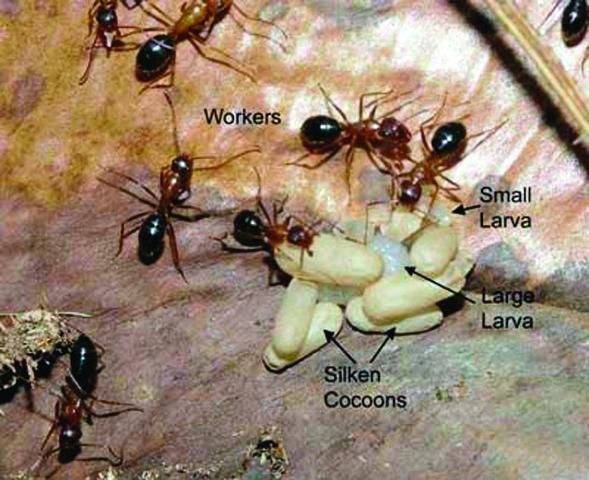
When the colony is two to five years old, depending on environmental conditions, new winged reproductives will usually be sent out. Alates are observed from spring to fall, depending on the area and environmental conditions. Queenless satellite nests are often founded within 20 to 100 feet of a mature nest. Determining the population size of carpenter ant colonies is difficult because they may consist of more than one nest. However, populations of 4,000 to 10,000 workers are commonly reported for most species.
Pest Status
Carpenter ants are one of the most common indoor insect pests. Carpenter ants will nest in wood structures and can be found nesting throughout a homeowner's home in wooden support pillars, window frames, and in attics. Homeowners often see these ants foraging inside their home at night. An experienced pest management professional, or a determined homeowner, can usually follow a trail of ants back to the ants' nesting site and treat it. Carpenter ant complaints are numerous during the spring swarm season, usually between April and June, when winged reproductives are often found in homes, mainly along window ledges and near sliding glass doors.
Foraging and Feeding
Florida carpenter ants tend to forage at night. The peak foraging hours are just before sunset until two hours after sunset, then again around dawn. The ants form very loosely defined trails, or individual ants wander alone. These ants have a fondness for sweets and can be found in campgrounds near soda machines and other areas where sweets are readily accessible. Similarly, they are fond of sweet floral nectars and honeydews produced by sucking insects, especially aphids, scales and mealybugs. Carpenter ants will also seek out other insects, both living and dead, for food. Carpenter ants have been reported preying on grasshoppers, crickets, leafhoppers, honey bees and caterpillars. Black carpenter ants will forage for proteins when their colonies are in the brood-production cycle during the summer and will always forage for carbohydrates year-round as an energy source.
Carpenter ants foraging in homes can be in search of sweets, moisture, or even new nesting sites, especially in kitchens, bathrooms or other rooms that have water leaks from plumbing or around doors and windows. Other potential nesting sites for carpenter ants are poorly ventilated attics and crawlspaces that have a humid environment that is attractive to the ants. Carpenter ants may trail from an interior nest to an exterior food source. Like many other ants, carpenter ants will trail along wires or cables that may be attached to homes and serve frequently as access routes for them to enter attics and other above-ground areas. Trees that touch houses and other structures form "bridges" that provide pest ants and other insects foraging access into buildings. Carpenter ants have also been seen trailing along wooden beams into and out of structures.
Management
Carpenter ants are among the top five pest ants in the United States. Direct treatment or removal of nesting sites is recommended because these sites harbor the brood, queen, and the bulk of the workers and winged reproductives. However, finding the nest sites can be difficult. Nonchemical techniques, such as structure exclusion and habitat modification, combined with judicious use of pesticides, can provide an effective carpenter ant management program. Trees that are providing nests for carpenter ants should be removed, treated, or trimmed. A small amount of insecticidal dust or spray applied directly to the nest area is usually sufficient to eliminate the nest. Excessive treatment can become repellent, actually causing the nest to move to another location if the dust or spray is applied near but not directly on the nest.
Observation of foragers entering voids is the best means of finding indoor nests (Figure 8). Watch for trailing ants at their peak nocturnal foraging hours and follow them. Look for areas of higher ant population density indicating closer proximity to the nest. The presence of ants and sawdust in crawlspaces and/or attics in a home also indicate an infestation (Figure 9). If alates emerge in a home during the winter or early spring, one can assume that there is an interior nest. If carpenter ant workers are found inside the home only in warm months, they may be scout ants from an outside nest. Nontoxic baits such as sugar milk, sugar water, honey, or dead insects placed along a foraging trail can cause other nestmates to be recruited to the area. Try to follow the foragers back to the nest and then treat the nest.
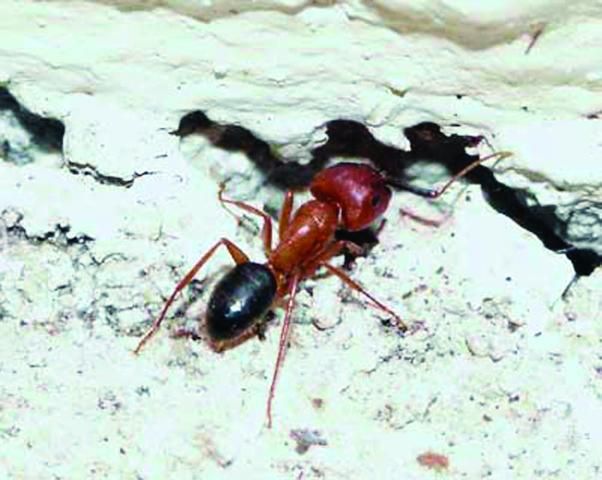
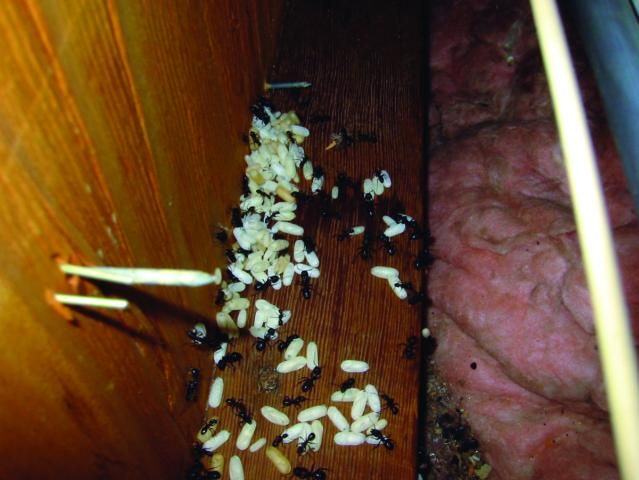
Credit: portlandhomeinspections.com
There are a number of treatment options for the chemical control of carpenter ants. A chemical treatment will consist of an insecticide application to wall voids and a perimeter spray to the outside of the structure. Toxic baits are an alternative for homeowners who do not want sprays used in their homes. There are many situations in which the nest is not accessible, or cannot be found. In these cases, use one of the baits made for carpenter ants, and follow the label directions. Usually baits are simply placed along the trail, and foragers bring the toxic baits back to the nest where food and toxicant are shared via trophallaxis (food sharing by regurgitation). Bait formulations can be liquid, gel, or solid. To be effective, they must be sufficiently attractive to stimulate recruitment. Carpenter ants are finicky eaters and tend not to recruit in large numbers to any food source thus decreasing the efficacy of insecticidal baits.
Residual sprays in foraging areas can also be helpful. Be sure to spray areas where ants are feeding, such as trees and shrubs. A systemic insecticide can help control aphids and other honeydew producers to reduce food for the carpenter ants.
Dusts are the most effective treatment for wall voids. They provide the longest residual control in dry areas and can be carried backed to the nest by foraging ants that have walked over the dusts. Read and follow label instructions and precautions before using any insecticide.
Cultural control practices entail using nonchemical materials to eliminate or exclude carpenter ants from infesting a structure. Repairing leaky pipes, caulking entry points, and removing damaged wood (Figure 10) are examples of cultural control practices. Eliminate "bridges" caused by trees and shrubs touching house exteriors. If wires or power cables are being used as bridges, it may be possible to have a professional treat the wires or areas where the wires attach to the structure. There are a number of "pest barrier" substances available that are sticky and can be used on tree trunks and other places to stop ants from passing. Using building materials designed to exclude carpenter ants in a structure is another example of a preventive strategy. Certain man-made lumbers have plastics incorporated into the product, making this lumber ideal for use in exterior structures such as decks. Insulation materials are also manufactured with impregnated borates and other compounds that repel or kill carpenter ants.
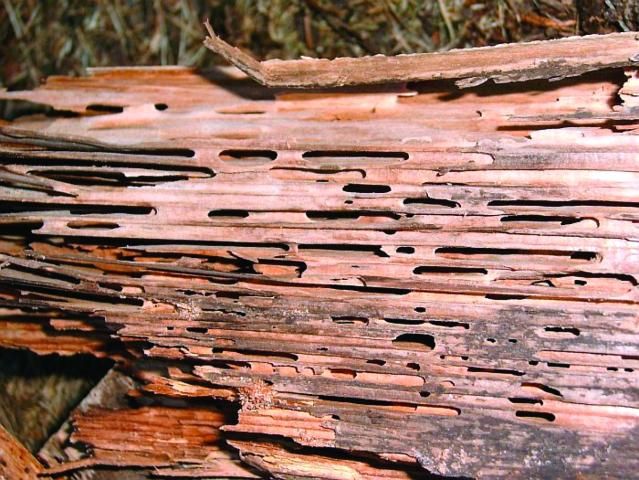
Credit: www.wdiohio.com